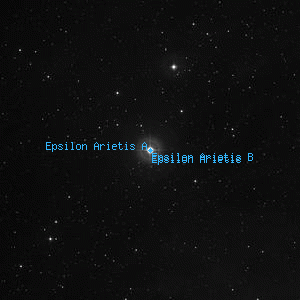Epsilon Arietis

Overlaid DSS image of Epsilon Arietis, 60' x 60' with north at top and west to the right
Aladin viewer for the region around Epsilon Arietis
ε Ari, 48 Ari
Σ 333, BD+20 484, GSC 01230-01424, HIP 13914, WDS J02592+2120AB
Σ 333, BD+20 484, GSC 01230-01424, HIP 13914, WDS J02592+2120AB
| Type | Binary Star |
|---|---|
| Magnitude | 4.63 | Right Ascension | 2h 59' 12.7" (2000) |
| Declination | 21° 20' 25" N |
| Constellation | Aries |
| Description | Binary 5.16/5.57 1.45" |
| Classification | A2IV+A3IVs |
Observing Notes
Andrew Cooper
Oct 24, 2020 Waikoloa, HI (map)
20cm f/6 Newtonian, Cave Astrola @ 136x
Seeing: 7 Transparency: 6 Moon: 25%
A close 1.4" binary of two white 5th magnitude stars, well matched with a mere 0.4 magnitudes of difference, just barely split in moments of good seeing, 47 Ari is 43' south
Andrew Cooper
Feb 27, 2020 Waikoloa, HI (map)
20cm f/6 Newtonian, Cave Astrola @ 61x
Seeing: 6 Transparency: 7 Moon: 19%
Blue-white, no companion noted, is binary 3.2/5.5 magnitude at 1.5", 6.7 magnitude HD18484 is 17' north, 47Ari is 43' south
Captain William Henry Smyth
Oct 9, 1835 No. 6 The Crescent, Bedford, England (map)
150mm f/17.6 refractor by Tully 1827
A very close double star, at the root of the tail. A 5, pale yellow; and B 6½, whitish. This is Σ.'s No. 333, of the order "pervicinæ;" he says that it is perhaps the closest of all his double stars "inter omnes nostras fortasse vicinissima." And H., writing to me in 1831, asks, "Have you tried ε Arietis? My twenty-foot, with power 480, has fairly separated it. I do not say it will always do so. I should like to see the telescope that will." It must, however, be widening, for I have divorced them myself latterly, though they generally hung in contact at my earlier attempts. A third star in the sp is so nearly in a line with the angle of position, that I was enabled to make use of it in my measures. The distances are mere estimations. The Rev. W. R. Dawes first saw this object double, in my observatory.
In his Catalogue of 1827, Professor Struve merely registered ε Arietis as being in contaclu; yet he subsequently paid such attention to it, that he suspected the components of variability, to the small amount of between 0 and 0.5 of his scale. This affords internal evidence that he watched them closely; but from their not appearing on the list of Mensuræ Secundæ, in 1837, he probably did not perceive their binarity. Still he affords a very valuable starting point, in the following mean:Pos. 188°87' Dist. 0".547 Ep. 1830.16An increase of angle had, however, become so apparent to me in 1839, despite of light measures, that ε Arietis was among my strictest agenda on repairing to Hartwell to make some re-measurements; when I found it considerably altered, and easier to manage. From the results then obtained, I can with some confidence state, that the acolyte has a direct orbital motion. From the present state of the data, this motion may be inferred to amount to about 0°.85 per annum, so that its revolution may be made in four centuries at most. If we may place dependence on the observations, as to the slight increase of distance, it will probably still widen for a few years longer, until the satellite shall have doubled the southern point of its course, which now seems to be on an ellipse shooting out from ε in the micrometric direction of 210°, with a major-axis about thrice the length of its minor.
[WDS 211° 1".50 2019 ]
ε Arietis, as well as δ, was named Botein, from al-botaïn, the little belly; as forming with δ and ρ3 the second chamber of the Manázil al Kamar, or Lunar Mansions, which, says Kazwíní, is placed in three dark stars which form an atháfí, a trivet or tripod. It is readily found, mid-way on a line drawn between the Pleiades and Hamal; and a ray shot from γ Pegasi between β and γ Arietis, in the Ram's head, and led as far again, strikes ε.― A Cycle of Celestial Objects Vol II, The Bedford Catalogue, William Henry Smyth, 1844
Other Data Sources for Epsilon Arietis
Associated objects for Epsilon Arietis
Nearby objects for Epsilon Arietis
3 objects found within 120'
| 47 Arietis | Epsilon Arietis A | Epsilon Arietis B |
Credits...
Drawings, descriptions, and CCD photos are copyright Andrew Cooper unless otherwise noted, no usage without permission.
A complete list of credits and sources can be found on the about page
Epsilon Arietis